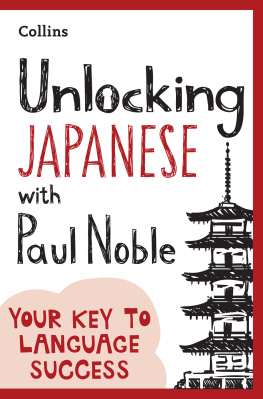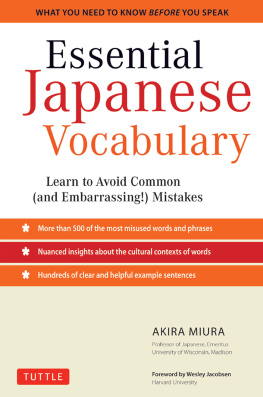UNLOCKING JAPANESE
by Cure Dolly
2016 Sun Daughter Press
CONTENTS
The mysteries of invisible Japanese pronouns and the real meaning of the wa particle
The fundamental structure of Japanese
How the textbooks are teaching Eihongo
by Cure Tadashiku
Make Japanese grammar work for you instead of against you
Meet the Queen and King of Japanese
(It isnt really passive at all)
Mighty Morphin Modularity
A link to the non-past
Chapter One
The Accidental Conspiracy
Is there a dark conspiracy among schools and textbooks to make Japanese seem far more complicated than it really is?
Of course not. But there might as well be.
Because the standard English textbook explanations of Japanese grammar do in practice make it far more complicated than it needs to be.
Once you know a few basic secrets, you can see that Japanese grammar is actually very straightforward, far more regular than English or other European grammar systems, and not all that difficult to grasp.
So why dont the standard texts tell you these secrets?
Of course there isnt any conspiracy. They arent deliberately concealing anything. The problem is that grammar is not in fact a set of rules by which language works. It is an attempt to describe how language works.
And the descriptions offered by the standard English-language texts on Japanese use the concepts of European grammar verb, adjective, conjugation, passive etc.
But Japanese is not a European language. It works differently from European languages. So none of these terms really fits Japanese properly. They leave an impression that there are all kinds of difficulties and exceptions and irregular things that you just have to remember.
But there arent.
Japanese is a remarkably regular and simple language compared to European languages.
But you have to treat Japanese as Japanese, not deal with it as if it were English that didnt quite work correctly.
And that is the problem.
Not some conspiracy to make a simple language unnecessarily complicated, but the fact that it is always described in terms that dont really fit it and modeled in ways that were made to describe a different kind of language.
That is the problem this book is going to fix.
A big claim, but I believe that if you read this book you will come to the conclusion that it is justified.
Fortunately, it isnt a case of learning a new and strange terminology to describe a completely alien language.
It is really just a matter of adjusting the way we look at Japanese. We will use simple, common-sense descriptions of what is going on in the language. We will continue to use some of the borrowed terms from European grammar, but making it clear in what ways they actually fit Japanese and in what ways they dont.
I cant take all the credit for this book. In the first place I owe an incalculable debt to Dr. Jay Rubin, whose groundbreaking book Making Sense of Japanese: What the Textbooks Dont Tell You first set me off on this path.
In particular, his exposition of the Japanese no-pronoun and the fact that the wa particle never marks the grammatical subject laid the foundation for several of the things I have to say. Once you fully understand these points, various other things logically follow from them that progressively build into a model that simplifies Japanese and allows it to be understood naturally on its own terms.
I am also indebted to Japanese elementary school textbooks, which explain Japanese to Japanese children using Japanese terminology naturally, in Japanese.
This last part is important, because one might think that native Japanese writers of textbooks in English would get closer to the way Japanese really works than foreign writers do. But this does not turn out to be the case. Crossing the language barrier is not as simple as it seems, and in trying to explain matters in terms that make sense to an English audience, they tend to fall into the same traps as native English writers (by whose work, of course, they are also influenced).
Because there is no model in English for how Japanese really works, the problem of explaining it has been difficult for anyone to overcome, regardless of her native language.
It is precisely that model that this book aims to provide.
I also gratefully acknowledge the very considerable help given to me by Cure Tadashiku (Annalinde Matichei) and Cure Yasashiku. Over several years, we have engaged in endless discussions in both Japanese and English that have helped to refine the ideas in this book. Cure Tadashiku has contributed a chapter to the book, and in Chapter Seven I explain how Cure Yasashiku supplied me with the final piece to a large puzzle. It was in fact the solution of this puzzle that led me to feel that the time was right to publish this book.
This particular puzzle piece involves the Japanese so-called passive and the ga particle, but it affects a number of other things because the Japanese language is an interlocking whole.
Indeed, looking over the table of contents, some readers may think that half this book is about particles. However, that is only partly true. The book is about how Japanese works, and since particles are the lynchpins of the language I talk about them quite a lot. However, in talking about them I am also talking about many other aspects of Japanese. Because of their fundamental nature, the easiest way to get a handle on many a question in Japanese is to seize it by the particles!
To a small extent I will be taking you on my voyage of discovery by presenting, alongside new material written specially for this book, some of the things that I have written along the way, though amended and expanded in the light of later discoveries.
Well begin with the first serious essay I wrote on this subject, which includes a recap of those parts of Dr. Rubins work that led to the underlying thesis of this book. We will then build out from there.
Chapter Two
I Am Not an Eel!
The mysteries of invisible Japanese pronouns and the real meaning of the wa particle
Using the ancient koan of the eel and the diner, the mysteries of invisible Japanese pronouns and the wa particle are about to be finally unveiled.
Enlightenment commences in 3 2
Watashi wa unagi desu
is a common joke among Japanese learners. It is a kind of expression Japanese people often use and the idea is that it literally means I am an eel.
After all, Watashi wa gakusei desu means I am a student, doesnt it?
What Watashi wa unagi desu really means, of course, when said in context (probably in a restaurant) is I will have eel. The common Western impression is that the speaker has literally said I am an eel, but by a sort of colloquial contraction it is understood in context to mean I will have eel. Even the scholarly and usually excellent Dictionary of Basic Japanese Grammar says that I am an eel is the literal meaning (an example of how explaining Japanese in English can be a problem even for Japanese people).
So what is the real solution to the eel conundrum?
First of all, lets look at the way nouns and pronouns are dropped (this is important to our eel, as youll see in a minute). This is sometimes considered very obscure and confusing. It isnt. It is really only doing what all languages do but in a slightly different (and rather more efficient) way. Consider this English passage:
As Mary was going upstairs, Mary heard a noise. Mary turned and came back down. At the bottom of the stairs, Mary saw a tiny kitten.
Is that grammatically correct? Of course it is. Just as correct as saying watashi wa all the time when it isnt necessary. Would any native speaker ever say it? Of course not.
Why not? Because having established Mary as the topic we dont keep using her name. We refer to her as she. Japanese refers to her as . That is to say, the Japanese equivalent of an English pronoun is what I arbitrarily refer to as . In other words, nothing at all. But that doesnt mean that the pronoun isnt there. Only that you cant see or hear it. It is crucially important to realize that it does in fact exist.
Next page









